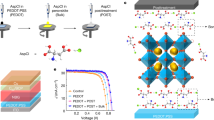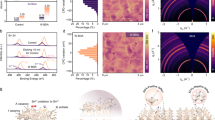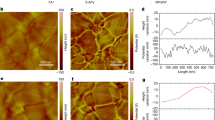Abstract
Perovskite solar cells have developed rapidly in the past decade. For fabricating highly efficient perovskite solar cells, efforts have been devoted to modulate the nucleation and crystallization processes of perovskite active layers by solvent, antisolvent and additive engineering. However, there is still a need for effective strategies to regulate perovskite nucleation and crystal growth and passivating in situ defects on the surface and at the grain boundaries. Here we introduce 1,4-butane sultone as the second solvent into the perovskite precursor solution to regulate the nucleation of the α-FAPbI3 layer. The interaction between 1,4-butane sultone and the solute decreases the density of nucleation and inhibits secondary nucleation. At the same time, the ring-opening conversion of 1,4-butane sultone during the annealing process produces 4-chlorobutane-1-sulfonate and 4-iodobutane-1-sulfonate, which effectively passivate the surface defects in the perovskite. As a result, treated n–i–p planar perovskite solar cells attain a power conversion efficiency of 26.5% (certified as 26.2%), with enhanced long-term stability.
This is a preview of subscription content, access via your institution
Access options
Access Nature and 54 other Nature Portfolio journals
Get Nature+, our best-value online-access subscription
27,99 € / 30 days
cancel any time
Subscribe to this journal
Receive 12 print issues and online access
209,00 € per year
only 17,42 € per issue
Buy this article
- Purchase on SpringerLink
- Instant access to full article PDF
Prices may be subject to local taxes which are calculated during checkout




Similar content being viewed by others
Data availability
All data are available in the Article or its Supplementary Information, and further data are also available from the corresponding author on reasonable request. Source data are provided with this paper.
References
Kojima, A., Teshima, K., Shirai, Y. & Miyasaka, T. Organometal halide perovskites as visible-light sensitizers for photovoltaic cells. J. Am. Chem. Soc. 131, 6050–6051 (2009).
Zhao, K. et al. peri-Fused polyaromatic molecular contacts for perovskite solar cells. Nature 632, 301–306 (2024).
Li, S. et al. Coherent growth of high-Miller-index facets enhances perovskite solar cells. Nature 635, 874–881 (2024).
Liu, S. et al. Buried interface molecular hybrid for inverted perovskite solar cells. Nature 632, 536–542 (2024).
Park, J. et al. Controlled growth of perovskite layers with volatile alkylammonium chlorides. Nature 616, 724–730 (2023).
Zhao, Y. et al. Inactive (PbI2)2RbCl stabilizes perovskite films for efficient solar cells. Science 377, 531–534 (2022).
Chen, H. et al. Improved charge extraction in inverted perovskite solar cells with dual-site-binding ligands. Science 384, 189–193 (2024).
Yang, Y. et al. Amidination of ligands for chemical and field-effect passivation stabilizes perovskite solar cells. Science 386, 898–902 (2024).
Boyd, C. C., Cheacharoen, R., Leijtens, T. & McGehee, M. D. Understanding degradation mechanisms and improving stability of perovskite photovoltaics. Chem. Rev. 119, 3418–3451 (2019).
Zhang, W. C. & Zhou, H. Q. Perovskite intermediate phases fundamentally address the urgent stability issue. Chem 7, 2862–2865 (2021).
Zhao, X., Liu, T. & Loo, Y. L. Advancing 2D perovskites for efficient and stable solar cells: challenges and opportunities. Adv. Mater. 34, 2105849 (2022).
Shao, J. et al. Recent progress in perovskite solar cells: material science. Sci. China Chem. 66, 10–64 (2023).
Luo, X. et al. Recent progress in perovskite solar cells: from device to commercialization. Sci. China Chem. 65, 2369–2416 (2022).
Yang, W. S. et al. High-performance photovoltaic perovskite layers fabricated through intramolecular exchange. Science 348, 1234–1237 (2015).
Bu, T. et al. Lead halide-templated crystallization of methylamine-free perovskite for efficient photovoltaic modules. Science 372, 1327–1332 (2021).
Jeon, N. J. et al. Solvent engineering for high-performance inorganic-organic hybrid perovskite solar cells. Nat. Mater. 13, 897–903 (2014).
Yang, M. J. et al. Perovskite ink with wide processing window for scalable high-efficiency solar cells. Nat. Energy 2, 17038 (2017).
Lee, J. W. et al. Tuning molecular interactions for highly reproducible and efficient formamidinium perovskite solar cells via adduct approach. J. Am. Chem. Soc. 140, 6317–6324 (2018).
Bu, T. et al. Modulating crystal growth of formamidinium–caesium perovskites for over 200 cm2 photovoltaic sub-modules. Nat. Energy 7, 528–536 (2022).
Chen, S. et al. Stabilizing perovskite-substrate interfaces for high-performance perovskite modules. Science 373, 902–907 (2021).
Jiang, Q. et al. Surface passivation of perovskite film for efficient solar cells. Nat. Photonics 13, 460–466 (2019).
Jeong, J. et al. Pseudo-halide anion engineering for α-FAPbI3 perovskite solar cells. Nature 592, 381–385 (2021).
Zhang, H. et al. A universal co-solvent dilution strategy enables facile and cost-effective fabrication of perovskite photovoltaics. Nat. Commun. 13, 89 (2022).
Zhang, Z. F. et al. DMSO-free solvent strategy for stable and efficient methylammonium-free Sn-Pb alloyed perovskite solar cells. Adv. Energy Mater. 13, 2300181 (2023).
Li, M. et al. Orientated crystallization of FA-based perovskite via hydrogen-bonded polymer network for efficient and stable solar cells. Nat. Commun. 14, 573 (2023).
Claridge, T. D. W. High-Resolution NMR Techniques in Organic Chemistry 3rd edn (Elsevier, 2016).
Huang, H. H. et al. A simple one-step method with wide processing window for high-quality perovskite mini-module fabrication. Joule 5, 958–974 (2021).
Schötz, K. et al. Understanding differences in the crystallization kinetics between one‐step slot‐die coating and spin coating of MAPbI3 using multimodal in situ optical spectroscopy. Adv. Opt. Mater. 9, 2101161 (2021).
Song, T.-B. et al. Revealing the dynamics of hybrid metal halide perovskite formation via multimodal in situ probes. Adv. Funct. Mater. 30, 1908337 (2020).
Bi, D. et al. Polymer-templated nucleation and crystal growth of perovskite films for solar cells with efficiency greater than 21%. Nat. Energy 1, 16142 (2016).
Zhao, Y. et al. Perovskite seeding growth of formamidinium-lead-iodide-based perovskites for efficient and stable solar cells. Nat. Commun. 9, 1607 (2018).
Ummadisingu, A. et al. The effect of illumination on the formation of metal halide perovskite films. Nature 545, 208–212 (2017).
Abdelsamie, M. et al. Additive-assisted room-temperature processing of metal halide perovskite thin films. ACS Appl. Mater. Interfaces 13, 13212–13225 (2021).
Parrott, E. S. et al. Growth modes and quantum confinement in ultrathin vapour-deposited MAPbI3 films. Nanoscale 11, 14276–14284 (2019).
Muhammad, Z. et al. Tunable relativistic quasiparticle electronic and excitonic behavior of the FAPb(I1–xBrx)3 alloy. Phys. Chem. Chem. Phys. 22, 11943–11955 (2020).
Han, Q. et al. Single crystal formamidinium lead iodide (FAPbI3): insight into the structural, optical, and electrical properties. Adv. Mater. 28, 2253–2258 (2016).
Zhang, Y. et al. Propylammonium chloride additive for efficient and stable FaPbI3 perovskite solar cells. Adv. Energy Mater. 11, 2102538 (2021).
Liu, M. et al. Localized oxidation embellishing strategy enables high‐performance perovskite solar cells. Angew. Chem. Int. Ed. 63, e202318621 (2024).
Paape, N. et al. Chloroalkylsulfonate ionic liquids by ring opening of sultones with organic chloride salts. Chem. Commun. 3867–3869 (2008).
Padma priya, M. P. & Rajarajeswari, G. R. Bronsted acid-functionalized choline chloride-butane sultone for the catalytic decomposition of cumene hydroperoxide to phenol. J. Chem. Sci. 130, 36 (2018).
Xing, Z. et al. Modulation of colloidal assembly behavior enables printable low-dimensional perovskite photovoltaics. Angew. Chem. Int. Ed. 62, e202303177 (2023).
Peng, L. & Xie, W. Theoretical and experimental investigations on the bulk photovoltaic effect in lead-free perovskites MASnI3 and FASnI3. RSC Adv. 10, 14679–14688 (2020).
Zhou, W. R. et al. Zwitterion coordination induced highly orientational order of CH3NH3PbI3 perovskite film delivers a high open circuit voltage exceeding 1.2 V. Adv. Funct. Mater. 29, 1901026 (2019).
Liu, K. et al. Zwitterionic-surfactant-assisted room-temperature coating of efficient perovskite solar cells. Joule 4, 2404–2425 (2020).
Chen, Y. H. & Zhou, H. P. Defects chemistry in high-efficiency and stable perovskite solar cells. J. Appl. Phys. 128, 060903 (2020).
Zheng, X. P. et al. Defect passivation in hybrid perovskite solar cells using quaternary ammonium halide anions and cations. Nat. Energy 2, 17102 (2017).
Yang, T. et al. One-stone-for-two-birds strategy to attain beyond 25% perovskite solar cells. Nat. Commun. 14, 839 (2023).
Zou, Y. et al. A crystal capping layer for formation of black-phase FAPbI3 perovskite in humid air. Science 385, 161–167 (2024).
You, S. et al. Bifunctional hole-shuttle molecule for improved interfacial energy level alignment and defect passivation in perovskite solar cells. Nat. Energy 8, 515–525 (2023).
Acknowledgements
This work was supported by the National Key Research and Development Program of China (no. 2024YFB4205200), the Strategic Priority Research Program of the Chinese Academy of Sciences via grant no. XDB 0520102 and the National Natural Science Foundation of China (nos. 52173188 and 52103243). Y.W. thanks Shenzhen HUASUAN Technology for assistance with the DFT calculations.
Author information
Authors and Affiliations
Contributions
L.M. conceived the idea, designed the experiments, analysed the data and co-wrote the paper. Y.W. performed the fabrication, measurement and analysis of the devices. C.L., M.C.L., C.Z. and Z.L. participated in the solar cell fabrication and characterization. S.Q. analysed the DFT data. J.Z. and M.R.L. performed the in situ PL measurements. Y.Z. and F.W. performed the TOF-SIMS measurements and analysed the data. X.L. analysed the NMR data. L.M. and Y.L. supervised the project. L.M., Y.W. and Y.L. wrote the paper. All authors contributed to the work.
Corresponding authors
Ethics declarations
Competing interests
The authors declare no competing interests.
Peer review
Peer review information
Nature Photonics thanks Guojia Fang, Rui Wang and the other, anonymous, reviewer(s) for their contribution to the peer review of this work.
Additional information
Publisher’s note Springer Nature remains neutral with regard to jurisdictional claims in published maps and institutional affiliations.
Supplementary information
Supplementary Information
Supplementary Figs. 1–25 and Tables 1–4.
Supplementary Data 1
Source data for supplementary figures.
Source data
Source Data Fig. 1
Source data for Fig. 1.
Source Data Fig. 2
Source data for Fig. 2.
Source Data Fig. 3
Source data for Fig. 3.
Source Data Fig. 4
Source data for Fig. 4.
Rights and permissions
Springer Nature or its licensor (e.g. a society or other partner) holds exclusive rights to this article under a publishing agreement with the author(s) or other rightsholder(s); author self-archiving of the accepted manuscript version of this article is solely governed by the terms of such publishing agreement and applicable law.
About this article
Cite this article
Wang, Y., Lu, C., Liu, M. et al. Solvent-assisted reaction for spontaneous defect passivation in perovskite solar cells. Nat. Photon. (2025). https://doi.org/10.1038/s41566-025-01704-2
Received:
Accepted:
Published:
DOI: https://doi.org/10.1038/s41566-025-01704-2



